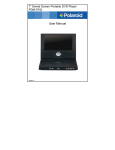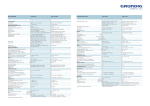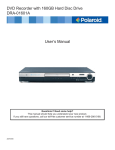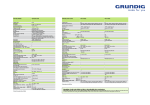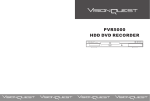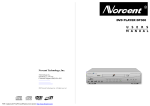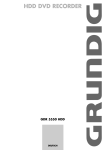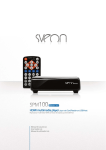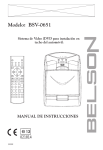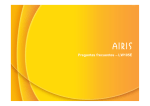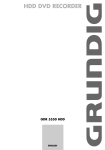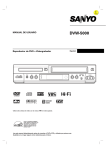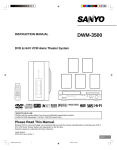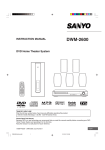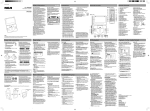Download TVGuardian DRM-2001G User's Manual
Transcript
DVD Recorder with 80GB Hard Drive DRM-2001G User’s Manual 20060425 Safety Instructions Danger symbol: The lightening flash with arrowhead symbol within an equilateral triangle is intended to alert the user to the presence of dangerous voltage in the unit. Warning symbol: The exclamation point within an equilateral triangle is intended to alert the user to the presence of important operation and maintenance (servicing) instructions. WARNING: To prevent fire or electric shock, do not expose the unit to rain or moisture. Never attempt to open the cabinet; dangerous high voltages are presented in the unit. Refer servicing to qualified service personnel when necessary. MAINTENANCE NOTICE: • Do not put the unit: near strong magnetic fields, somewhere exposed direct sunlight or near heat radiation equipment (such as a heater), on top of other heat radiation objects, in a place with bad ventilation and dirt, somewhere subject to vibration and instability, or somewhere exposed to moisture or rain. The unit should be installed in a smooth and dry place with good ventilation. • When the unit is moved from a cold place to a warm one, the laser head may get dewed and the unit may not work normally. In this case, keep the power on for an hour or two (with no disc loaded) before playing normally. • Clean the surface of the unit with neutral detergent. Do not use organic solvents such as alcohol or gasoline. Never polish the unit with sand paper. • If the unit is not to be used for a long time, disconnect the power plug from the wall outlet. • For optimum performance, do not place heavy objects on the unit. CAUTION: • The unit employs a laser system. To prevent direct exposure to the laser radiation, do not attempt to open the cabinet. Visible laser may radiate when the cabinet is opened or the interlocks are defeated. • Do not stare at laser beams. • To ensure the proper use of the unit, read this manual carefully. • Keep this manual for future reference. If the unit requires servicing, please contact the seller or service center. Table of Contents Identification of Controls Remote Control System Connections System Setup TVGuardian® Feature Recording Mode Creating a YesDVD™ Timer Recording Play Mode Hard Disc Drive Play Mode Disc Operation Hard Disc Drive Editing Title Editing Chapter Editing Troubleshooting Specifications Glossary of Terms 4 5 7 10 19 20 23 24 26 33 37 39 42 43 45 46 47 Identification of Controls FRONT PANEL 1. Power button 2. Standby LED 3. IR (Remote Sensor) 4. DVD Door 5. Display 6. Open/Close button 7. Source button 8. Play button 9. Stop button 10. Record button 11. Digital video input 12. Audio input (front left) 13. Audio input (front right) 14. Composite video input (front) REAR PANEL 1. RF signal input 2. RF signal output 3. Composite video input (rear) 4. S-video input 5. Audio input (rear left/right) 6. 5.1Ch audio output 7. Composite video output 8. S-video output (rear) 9. Digital audio-optical output 10. Digital audio-coaxial output 11. Component videos input 12. Component videos output (Y, Pr/Cr, Pb/Cb) 4 Remote Control 1. 2. 3. 4. 5. 6. EJECT button DV button HDD button NUMBERS (0-9) buttons SETUP/EXIT button LEFT DIRECTION/REPLAY button RIGHT DIRECTION/SKIP button (UP/DOWN/LEFT/RIGHT) 7. OK button 8. TIMER button 9. TIME SHIFT button 10. REC/OTR button (RECORD/ONE-TOUCH RECORD) 11. PLAY button 12. STOP button 13. REVERSE button 14. PREVIOUS button 15. FWD button 16. NEXT button 17. AUDIO button 18. MENU button 19. SUBTITLE button 20. ZOOM button 21. POWER button 22. INPUT button 23. DVD button 24. GOTO button 25. ADD/CLEAR button 26. NAVIGATION button 27. RETURN button 28. REC TO button 29. SLOW/SORT button 30. PAUSE/STEP button 31. CHANNEL+ button 32. VOLUME+ button 33. CHANNEL- button 34. VOLUME- button 35. PS/IS (PROGRESSIVE/ INTERLACE SCAN) 36. REPEAT button 37. DISPLAY button 38. MUTE button 5 Remote Control To install batteries and use remote control: Notes: • Do not drop the remote control or leave it in places with high humidity. • Do not leave the IR remote sensor exposed to direct sunlight or bright light. • Do not mix old and new batteries should they need replacing. • Do not use rechargeable batteries. • Remote range = 16 feet. 6 System Connections CONNECT TO A TV Before connecting the system, be sure to turn off the power source of this unit and other devices. • • • • There are three kinds of video outputs in this unit: component video, S-video, and composite video. You can select one of the available video inputs of the TV and make the connection. In terms of picture quality, the component video is the best, followed by S-video, then composite video. When connecting the audio output of the unit to the TV, connect the left and right audio outputs to the TV audio inputs of the same group as the connected video inputs. Component video and S-video cables not included. 7 System Connections CONNECTING TO 5.1 CHANNEL AMPLIFIER CONNECTING TO AN AMPLIFIER WITH DIGITAL DECODER • • In audio setup, set the “Digital Output Mode” to “LPCM Output” (For details, see “System Setup: Digital Audio Output” section.) When using a digital signal output (coaxial or optical), the Analog Output cable is not needed for connection. 8 System Connections CONNECTION FOR RECORDING EXTERNAL SIGNALS (FRONT PANEL SIGNAL) Before connecting with external signals be sure to turn off the power source of this unit and other devices. Notes: • Refer to your user’s manual when connecting the unit. • Turn off the power and unplug both units before setting up any connections. CONNECTION FOR RECORDING EXTERNAL SIGNALS (REAR PANEL SIGNAL) • • From the video input terminals, select one as desired. In terms of picture quality, composite is good, S-video is better, and component is best. 9 System Setup Operation Interface and General Steps This section will introduce the menu interface of the System Setup and general operation steps. • Press the “SETUP” button to enter the System Setup mode. The system setup control bar menu will appear on the top of the OSD, as shown in the following chart. • Use the ▲ or ▼ button to make a selection and press the “OK” button to enter the setup menu. In the setup menu of each item, press the arrow buttons and the “OK” button to operate the control units. The corresponding settings will be done. • Press the “RETURN” button to return to the upper level menu. Press the “SETUP” button to exit the system setup mode. NOTES: • The steps above are general and typical operations. Some settings might not need a certain step or require more steps. • Please set up the system in the Eject Disc mode or No Disc mode, otherwise some settings cannot be done. Auto Chapter Marker 1. In the Recording Settings menu, use arrow buttons to select “Automatic Chapter Marker” and press the “OK” button to drop down a menu. 2. Use the ▲ or ▼ button to select a proper value ( 5min, 10min, 20min, 30min or off), and press the ”OK” button to confirm. 3. Press the “RETURN” button to return to the upper level menu and set up other items. • Use different time options to insert chapter markers at x-minute intervals during recording. 10 System Setup Recording Quality 1. In the Recording Settings menu, use the ▲ or ▼button to select the “Default Quality” item, and press the “OK” button to drop down a menu. 2. Use the ▲ or ▼button to select a desired value and press the “OK” button. 3. Press the “RETURN” button to return to the upper level menu and set up other items. • For the differences of the six quality levels, SP, SP+, LP, SLP, EP and HQ, see the glossary for reference. APS (Auto Program Scan) • This is the TV channel scanning process. This should be preformed after connection to an off-air broadcast. • The unit has a channel tuner. You can receive TV signals directly from the unit. • Before the tuning, you must conduct a channel scan to enable the unit to tune in various channels automatically and determine their frequencies. The tuned channels will be saved automatically. Even if the power is off, the saved channel information will not be lost. 1. Press the “SETUP” button to enter the “System Setup” mode. 2. Use the ▲ or ▼ buttons to highlight “APS”. 3. Press OK button. The tuner will start searching through various channel frequencies and add available channels to the system memory. This procedure may take several minutes. 4. When the scan is complete, “TOTAL CHANNELS FOUND” will appear on the screen with the number of channels that have been stored to memory. 5. Press the “SETUP” button on the remote control to exit. Notes: • If you are using a set-top box (cable TV receiver or satellite broadcast receiver), set the DVD recorder to channel 3 or 4 (depending on your equipment). • Be sure to connect the antenna properly before the channel scan operation. • Make sure there are TV signals at the TV Signal Input. 11 System Setup Modify Channel Use the ▲ or ▼ button to Select the “Modify Channel” item, in dialog chart select “OK”. If you want to edit channels for the received TV programs, select the “Modify Channel” item, press “OK” button to confirm, in the pop up channel edit dialog box, use the ▲ or ▼ button and the “OK” button to select and confirm. The steps of channel edit are as follows. • “Program Number”: Current TV program number. • "Name” CH031: You can change the name using the ▲ or ▼ button and “OK” button. Press the ▲ or ▼ button to move the cursor. • Frequency: 551.3 MHz. When the search type is selected Frequency, this item will be shown as the frequency. Press the ▲ or ▼ button to scan channels manually by frequency. • "Fine Tuning”: Use the ▲ or ▼ and “OK” buttons to select this item and press the ▲ or ▼ button to fine tune the frequency lightly. • Skip: Yes or No, use the ▲ or ▼ and “OK” buttons to select this item, you can select Yes or No to decide whether to skip this channel. • After the channel to information is modified, select OK and press the “OK” button to confirm. Then return to the Channel Scan menu. SETUP MENU VIDEO TV Type The product supports two different television systems that are incompatible with each other. NTSC is the television system that is adopted in the North America region, PAL is the television system that is adopted typically in the rest of the world especially in Europe and Asia. 1. In the General Settings menu, select the “TV Type” item and press the “OK” button to drop down a menu. 2. Select PAL or NTSC. 3. Press the “OK” button to confirm. This setting must be in accordance with the TV system; otherwise the video output might not work properly. 12 System Setup TV Display 1. In the Play Settings menu, press the “OK” button to select the “TV aspect ratio” item and a drop down menu will appear. 2. Use the ▲ or ▼ button to select a proper setting value and press the “OK” button to confirm. • 16:9WS is suitable for a wide screen TV. • Pan Scan is suitable for a TV with standard screen size. • When a wide screen picture is played, the left and right margins will be cut and the picture will occupy the entire screen. • 4:3 is uses for standard TV. When a wide screen picture is played, a black frame will appear at the top and bottom of the TV screen. • The default value is Letter Box. 3. Press the “RETURN” button to return to the upper level menu and set up other items. NOTES: • The playing effect depends on the recorded picture size. Some pictures might not be played under the screen format you select. • For those discs recorded as 4:3, no matter how the screen format is set, the screen format played is always 4:3. • The selection of screen format shall be in accordance with the TV screen. Video Output Format 1. In the General Settings menu, use the ▲ or ▼ button to move the cursor, select the “Video Output Format” item and press the “OK” button. 2. Select the Progressive or Interlace option for video scan output mode, and press the “OK” button to confirm. Video Output 1. In the General Settings menu, use the ▲ or ▼ button to move the cursor, select the “Video Output” item and press the “OK” button. 2. Select Y Pb Pr, RGB or CVBS terminal according to your need and press the “OK” button to confirm. Close Caption 1. In the General Settings menu, use the ▲ or ▼ button to move the cursor, select the “Close Caption” item and press the “OK” button. 2. When you play a DVD disc or receive a TV signal with subtitle, select the “ON” state, the TV screen displays subtitle, select the “OFF” state, the TV screen does not display subtitles. 13 System Setup YesDVD 1. In the General Settings menu, use the ▲ or ▼ button to move the cursor, select the “YesDVD” item and press the “OK” button. 2. When you want to create a “YesDVD disc” select “ON”. If not, select the “OFF”. • If you want to know more about creating a YesDVD, see the “Creating a YesDVD” section of this manual. SETUP MENU-AUDIO 1. Enter the System Setup control menu. 2. Use the ▲ or ▼button to select the “AUDIO” item. 3. Press the “OK” button to enter the Play Setting mode. Analog Audio output The unit can set the analog audio output at 2-CH or 5.1-CH. The output of 2-CH comes from L and R channels. 1. Enter the play settings menu, use the ▲ or ▼ button to select “SPDIF Output” item, and press the “OK” button. 2. Use the ▲ or ▼ button to select 2-CH or 5.1-CH, and press the “OK” button to confirm. SPDIF Output This unit has a digital audio output. You can enjoy music of better quality through an amplifier with a digital audio decoder. 1. Enter the play settings menu, use the ▲ or ▼ button to select “SPDIF Output” item, and press the “OK” button to drop down a menu. 2. Use the arrow buttons to select a proper value (RAW, LPCM), and press the “OK” button. 3. Press the “RETURN” button to return to the upper level menu and set up other items. LPCM Output The unit can set the LPCM96K and LPCM48K difference Audio Sampling frequency. Dynamic Range The unit can set the “full →3/ 4→1/ 2→1/ 4 → off” value. You can select different value to compress Audio output range. You can feel the difference of Audio output effect under different values. 14 System Setup SETUP MENU-LANGUAGE To satisfy the needs of consumers in different regions, the unit provides various interfaces languages. 1. Enter the system setup mode. 2. In the System Setup control bar menu, use the ▲ or ▼ button to move the cursor, select the “Language” item, and press the “OK” button to enter the Language Settings menu, which contains four items, as shown in the chart. System Language 1. In the Language Settings menu, use the ▲ or ▼ button to select the “System Language” item, and press the “OK” button to drop down a menu. 2. Use the ▲ or ▼button to select the language you want and press the “OK” button to confirm. The interface language will change immediately according to the settings. Audio Language 1. In the Language Settings menu, use the▲ or ▼button to select the “Audio Language” item, and press the “OK” button to drop down a menu. 2. Use the ▲ or ▼ button to select the language you want and press the “OK” button. • If you play a DVD disc supporting the selected language, the system will adopt that language as the DVD menu language. • If the disc doesn't support the selected language, the system will adopt the language provided by the disc. Subtitle Language Some DVD discs may contain various subtitle languages. This setting is to determine the default DVD subtitle language. 1. In the Language Settings menu, use the ▲ or ▼button to select the “Subtitle Language” item, and press the “OK” button to drop down a menu. 2. Use the ▲ or ▼ button to select the language you want and press the “OK” button. • “Off” means the subtitle output is off. • The system will give priority to this setting as the DVD subtitle language. If the DVD played does not support the selected language, the setting shall be invalid. • You can change the subtitle language at any time during playing. See “Play Mode” for details. Menu Language 1. In the Language Settings menu, use the ▲ or ▼button to select the “Menu Language” item, and press the ”OK” button to drop down a menu, as shown in the following chart. 2. Use the ▲ or ▼ button to select the language you want and press the “OK” button. • The system will give priority to this setting as the DVD audio output language. If the DVD played does not support the selected language, the setting will be invalid. • You can change the audio language at any time during playing. See “Play Mode” for details. 3. Press the “RETURN” button to return to the upper level menu and set up other items. Notes: • For the DVD language settings in this section, some discs might not contain the language you set. In this case, your settings will be invalid. The language played will be the one that is provided by the disc. • Some discs may contain a language selection menu, your selection in this menu rather than the corresponding settings of the unit will be effective. 15 System Setup SETUP MENU-DATE/TIME Date-Time Setting The time and date have to be set before a timed recording can be set. There are two ways to set the product clock: AUTO setting and MANUAL setting. 1. Press the “INPUT” button on the remote control to display the SYSTEM SET-UP MENU. 2. Use the CURSOR buttons to highlight Date-Time Setting bar and press the “OK” button. 3. Use the ▲ or ▼ buttons on the remote control to move the highlighted bar to Date-Time setting and press the “OK” button to select Auto or Manual. • Auto: If a Public Broadcasting Station (PBS channel in USA) is available in your area, the clock may set itself automatically by tuning to this channel. • Manual: If the clock does not automatically set itself, the clock will need to be manually set. Notes: • Make sure the antenna or cable box connections are correct. • Change the channel to the local PBS station. Program If you select Auto in the Date-Time setting optical bar, you must select a Public Broadcasting Station (PBS channel in USA) which is available in your area, the clock will set itself by tuning to this channel. Date(dd/mm/yy) 1. Press the “INPUT” button on the remote control to display the SYSTEM SET-UP MENU. 2. Use the CURSOR buttons of the remote control to select the Date (dd/mm/yy) and press the “OK” button to confirm. 3. Enter the correct date in mm/dd/yy format (Month/Day/Year) using the 0…9 keys. Time(hh/mm) 1. Use the CURSOR button of the remote control to select “TIME” and press “OK” to confirm. 2. Enter the correct time in hh:mm:ss format (Hour: Minute: Seconds) using the 0...9 keys. 3. After the date and time have been entered, press the “SETUP/EXIT” button on the remote control to exit. 16 System Setup SETUP MENU-PREFERENCES Reset to Factory Default When your unit doesn’t work properly, it is possibly due to some wrong settings. Please try the “Reset to Factory Default” function to see if the unit can restore to its normal working status. 1. In the General Settings menu, use the ▲ or ▼ button to select the “Reset to Factory Default” item and press the “OK” button. The OSD will display as follows. 2. Use the ▲ or ▼ button to select “OK” 3. Press the “OK” button to restore all default settings. Screen Saver The Screen Saver function means that when the unit is idle (or without monitored output) for some time, some interesting pictures will appear automatically on the screen as a screen saver. 1. In the General Settings menu, use the ▲ or ▼ button to move the cursor and select the Screen Saver item. 2. Press the “OK” button and the screen saver item will drop down a list. 3. Use the ▲ or ▼ button to move the cursor, and select ON or OFF. 4. Press the OK button to activate or inactivate the Screen Saver function. When the screen saver appears, press any button to exit. 5. Press the RETURN button to return to the upper level menu and set up other items. 17 System Setup SETUP MENU-TIME SHIFT Time shift default source: Tuner (ON): When the system is turned on, it will enter the tuner and time shift on state automatically. FCVBS (OFF): It will enter FCVBS and time shift OFF state automatically. Time shift buffer mode: Use the arrow button to highlight the Time Shift buffer mode row and press the “OK” button to select Refresh or Preserve. 1. Refresh (or flush) mode deletes all recordings in the buffer upon changing the TV channel. 2. Preserve maintains the content of the buffer upon changing the TV channel. Space management 1. Automatic: When Space Management is ‘Automatic’ and the HDD is full, the system should overwrite un-protected titles in FIFO scheme (the exception is when the title is selected to be dubbed - in which case, the title shall be kept until dubbing is over). FIFO means First in/First out. 2. Manual: When Space Management is ‘Manual’ and the HDD is full, the system will show the Popup message: The hard disc drive is full. Please erase some programs to perform further recordings. Empty hard disc 1. Erase all programs on HDD 2. A message will be shown: All video programs on the hard disc drive will be deleted. The system will automatically restart. Select “GO” or “NO” (default) Erase optical disc 1. Erase all programs on optical disc 2. A message will be shown: All video programs on the optical disc will be lost, continue? Select “OK” or “NO” (default) 18 TVGuardian® Feature This product supports TVGuardian Foul Language Filtering Technology, offering your family the very best control of objectionable language in your home. HOW IT WORKS: TVGuardian® (TVG) filters out objectionable language by monitoring the closed-captioned (CC) information. When TVG® detects objectionable words or phrases, it mutes the audio and displays more appropriate “profanity free” phrases. TVGuardian® technology also offers various levels of filtering and is easily adjustable with simple on-screen menus. NOTE: the following images are for representation purposes only. The actual layout may differ from that represented here. To activate the TVGuardian® feature, visit www.TVGuardian. com or call 1-866-TVG-FILTER (866-884-3458). Please have your “Registration Key” ready. (Activation requires a one-time fee of $19.95. PLEASE NOTE: Phone-in activation incurs an additional $4.95 service fee. Taxes added where required.)** ACTIVATION: Once you have obtained your Activation Code, please use your remote control to enter the activation code. Once activated, you may use TVGuardian® for the life of your product. TVGUARDIAN® MODES: Off : No filtering Tolerant: Filters only the most offensive foul language Moderate: Increased standards for language filtering Strict: Filters out all common offensive language WORD SUBSET FILTERING: In addition to the main TVGuardian® Modes listed above, you can turn certain word subsets on or off according to your preferences. Hell & Damn: Filters our variations of “Hell” and “Damn” Religious: Filters out references to deity (To watch religious programming, turn this word subset off ) Sexual: Filters sexually explicit language CC MODE: On Mute: (Default) Captions are displayed when offensive language is being filtered On Continuous: Captions are always displayed continually (see NOTE (2) below) CC Channel: To use the TVG® captioning features while watching a DVD movie, your television must be capable of displaying closed captions. Make sure your TV CC is set to “CC2” or “C2” (Close Caption on channel 2), and that the CC channel on your DVD player is set to “CC2” (this is the default setting). NOTE: TVGuardian® filters 95% of foul language of the words that are closed captioned. TVG® monitors the CC for words and phrases that are commonly considered to be offensive. TVG® will not filter out scenes, do “voice over”, or filter all words and phrases that anyone may consider to be offensive. Errors in CC can cause TVG® to miss words or phrases. TVG® works on media that includes closed captioning information. Some companies may not include their CC on all of their DVDs; you can verify whether a DVD supports Closed Captioning by identifying the CC logo on the back cover of the DVD case. (2) Replaced Closed Captioning phrases are available through the TV’s Closed Captioning decoder. If the TV does not have a Closed Captioning decoder, such as the LCD screen of portable DVD players, replaced phrases may not be displayed. Regardless, TVG® will mute the filtered language. ** All prices and fees are correct at the time of printing and are subject to change without notice. 19 Recording Mode Recording modes: • There are various external signal inputs in the unit, including S-Video, composite video, TV tuning, DV input and stereo audio input. You can select any group of audio and video signals from these inputs for recording. • There are six available recording modes of different qualities, including SLP (6 hours), EP (4 hours), LP (3 hours), SP+ (2.5hours), SP (2 hours) and HQ (1 hour). • The unit has a function of timer recording. You can set up a recording schedule in advance. The unit will record the programs that you select automatically. Entering the recoding mode and menu description: To enter the recording mode: 1. In the disc mode, press the “INPUT” button to enter the Monitoring Mode. The Monitoring Mode can be regarded as a sub-mode of the Recording Mode. 2. The system will automatically enter the Recording Mode when the setup time is reached. For details about timer recording, see “Timer Recording” for reference. 3. In the Recording Mode, press the “DISPLAY” button to show or hide the recording control bar menu. Manual Recording: Recording Source: You can select which video input the unit should record from. The following options are available: Rear Composite, Rear S-Video, Tuner, Front Composite, DV, and YPbPr Input • Press the “INPUT” button (repeatedly) to change the video source and select one of the above. Note: If you are recording from a rear source, make sure your audio connections are connected to the rear audio inputs. If you are recording from a front source, make sure your audio connections are connected to the front audio inputs. Recording to DVD or HDD Select to record to hard drive or optical disc: 1. Press the “TIME SHIFT” button once to switch to manual recording mode. 2. Press “REC TO” button to switch between the HDD or DVD Record sources. If you have a recordable media in the tray, you can press “REC” and start recording (OTR) to DVD. 3. Press Stop to finish recording. Notes: • The product will continue to record until the disc is full. • To set the product to record for 30 minutes only, press the “RECORD” button after recording has started. A message will be displayed on the screen indicating that the unit will record for 30 minutes. • Each time the “RECORD” button is pressed, an additional 30 minutes will be added to the record time. • To pause the recording, press the “PAUSE” button on the remote control. • Press the “PAUSE” button or the “REC” button to resume recording. Recording will continue until the “STOP” button on the remote control or the product front panel is pressed. • Press the remote control “TIME SHIFT” button once to turn on Time Shift mode. Press the button twice to switch to manual recording mode. • Press the “REC TO” button to switch between the HDD or DVD record sources. 20 Recording Mode Recording Quality: You can select from up to six record quality settings to define the picture quality of the recordings and the amount of space you want to use on the DVD/HDD. Higher quality recordings will consume more space and low quality recordings will consume less space on the DVD/HDD. NOTE: Use the “ADD/CLEAR” button to switch between different record quality options. Record Quality Record Time (4.7GB, DVD) Recording Time (80GB, HDD) Video Quality HQ (High Quality) 1 hour 17 hours Best SP (Standard Play) 2 hours 34 hours Very good SP+ (Standard Play) 2.5 hours 42 hours Good EP (Extended Play) 3 hours 51 hours Normal LP (Long Play) 4 hours 68 hours Moderate SLP (Super Long Play) 6 hours 102 hours Low One Touch Recording (OTR): This function enables you to set up the timer during the recording process. Once the scheduled time is reached, the system will stop recording automatically. 1. Enter the “Recording Mode” and start recording. 2. For desired timer recording, press the “REC/OTR” button once or several times. • The recording time will increase by 30 minutes with every pressing of the “REC/OTR” button. • If the scheduled time exceeds the recordable time of the disc, normal recording mode will restore. • If the timer recording is paused or stopped, the system will cancel the timer recording process. DV Controlled Recording: This unit can perform real-time monitoring and recording for a DV through the IEEE 1394 serial port (DV). 1. Connect the DV to the unit (for details, see “System Connection: System Connection for Recording External Signals”) by using the front panel inputs. 2. Switch on the power of the unit. 3. Press the “DV” button. 4. Switch on the “power” button of the DV, set it to the “CAMERA” mode, and start monitoring. 5. Press the “REC/OTR” button to start recording. (Other operations is the same as in the Recording Mode) This unit can also record the VCR content of the DV. 1. The connection method is the same as stated in the first 3 steps of 1. 2. Switch on the “Power” button of the DV to enter the VCR status, and ensure the VCR status is “Stop” 3. Use the remote control to complete the operations of the DV, including STOP, PLAY, PAUSE, FB, FF, etc. 4. Press the “REC/OTR” button and then press the “PLAY” button to start recording. 5. During the recording process, press the “PAUSE” button to suspend recording of the unit, and press the button again to suspend the DV. To restore play of the DV, press the “PLAY” button; if you press the “REC/OTR” button, the play of the DV and the recording of the unit will resume at the same time; press the “FWD” or “REV” buttons to complete forward or rewind operation for the DV, while it reports Pause status to the unit; if you press the “STOP” button, the recording of the unit will stop first, and press again to stop the play of the DV. Notes: • Do not move the unit or switch off the power during the recording process. • The finalized DVD+R disc could not be recorded. • Be sure to switch off the power of the unit and the DV before connecting the DV cables. 21 Recording Mode Record from hard drive to optical disc Press the “HDD” button and enter into the HDD display state. Press the “ADD/CLEAR” button to select the five titles you desire to copy to DVD. Press the “REC” key to copy selected file to DVD. Notes: • In DVD tray, there should be a blank re-writable DVD disc, or the disc was previously used for archiving from HDD only. • When recording from HDD to an optical disc, there will be a flashing icon on the upper left corner of the screen to indicate the recording process. 22 Instructions for Creating a YesDVD™ WHAT IS YesDVD™ YesDVD™ is a product of YesVideo (www.yesvideo.com) that allows you to transfer your videotapes or other video content to a DVD+R/RW with the professional quality features found in Hollywood DVDs. YesDVD™ will automatically: Analyze your video and create chapter points at natural scene breakers • Generate a Hollywood-style menu with pictures of each chapter for easy scene selection • Produce three, one-minute music videos using the best footage from your video • Create a DVD case cover sheet to be printed on your computer. The DVD cover sheet includes pictures from • your video and fits in a standard 5” x 7” (13.5cm x 19cm) DVD case. HOW TO CREATE A YesDVD: Step 1: With your remote control, press the “SETUP” button to enter the setup menu. Step 2: Use the remote control arrow buttons to highlight the “YesDVD” option and select “ON”. Step 3: Before recording, place a blank DVD+R/RW disc in the DVD tray. Step 4: Select input signal source and press the “RECORD” button to start recording. Step 5: You may stop recording by pressing the “STOP” button on the remote control. A dialog box will appear, asking if you would like to create a YesDVD™ disc. Select “YES” to create a YesDVD™. Step 6: Printing the DVD case cover sheet. After the YesDVD™ disc creation has completed, remove the • DVD from the DVD recorder. Insert your YesDVD™ disc into your MS-Windows™ • computer’s DVD drive. A window will pop up with printing instructions. Print the DVD case cover sheet. • Use scissors to cut the case cover sheet out of your printer • paper. Insert your DVD case cover sheet into a standard 5” x 7” DVD • case. NOTES: 1. The television system (TV type) of input signal source must be consistent with the DVD recorder; otherwise, the YesDVD™ disc cannot be created. 2. If your recording is longer than five minutes, music highlights will be created from your footage. 23 Timer Recording You can set-up the unit to schedule recordings to begin and end at a specific time. You can record to the hard drive or directly to a DVD. This feature is useful if you know the specific quality, time, date, and channel of a program you want to record in advance. 1. Press the “TIMER” button to enter the timer recording schedule setup menu, as shown in the chart to the right. There are 8 records in this menu. Each record represents a recording schedule. 2. In the timer recording setup menu, use the ▲ or ▼ button to select a record, and press the “OK” button. Setting up the input source: In the Item Editor dialog box, use the ▲ or ▼ and “OK” buttons to select the value of “SOURCE” Setting up the recording quality: In the Item Editor dialog box, use the ▲ or ▼ and “OK” buttons to select the recording quality. For more information about recording quality, for reference: HQ, SP, SP+, EP, LP, SLP. Set up the recording mode: This setting is done with the third control unit in “Item Editor” dialog box. Move the cursor ▲ or ▼ to select the row, and press the “OK” button to initiate the drop-down menu. The settings are as follows: Weekly: recording every week. Daily: recording everyday Once: recording on a certain date Setting up the recording date: • If you select “Weekly” press the “OK” button to confirm. Move the cursor to the right and press the “OK” button to pop up a week list, as shown in the chart. Select the day(s) you want to record. • If you select “Once” press the “OK” button. The date input editor box will appear on the right. Highlight the box and press the “OK” button, and then use the number buttons to enter the date in the form of “DD/MM/YY” press the “OK” button to confirm. If the input is invalid, the system will prompt an input error message. At the same time, the “Date Input Editor Box” will be left empty. Please enter the date again. 24 Timer Recording Setting up the starting time of recording: In the “Item Editor” dialog box, use the arrow buttons and the “OK” button to highlight the “Start” option. Enter a value between 0:00 and 23:59 with the number buttons and press the “OK” button to confirm. This function is used to set up the starting time of the recording. If the input value is beyond the range of 0:00-23:59, the system will give an invalid message. Setting up the end time of recording: Setting up the end recording time is similar to setting the starting time, as described in the above section. In the “Item Editor” dialog box, use the arrow buttons and the “OK” button to highlight the “End” option. Enter a value between 0:00 and 23:59 with the number buttons and press the “OK” button to confirm. This setting means when the end time is reached, the recording process will be stopped and the unit turns to standby status. Record To source: You may choose to record directly to a disc or the hard disc drive. Setting up the record title: Use ▲ or ▼ arrows to change the letter and press the “OK” button to enter it. To delete a set timer recording: Select any timer recording item and press the “ADD/CLEAR” button to delete it. Notes: • After setting up the timer recording schedule, configure the system according to the schedule and make sure the system is in standby or working status. • If the system is conducting another operation 5 minutes before the scheduled recording time, an information box will pop up prompting you whether to start recording or not. If you still want to record, highlight press the “OK” button to confirm. If the information box is left unattended, the system will automatically record. • If the system is in standby status, it will enter the recording mode automatically 3 minutes in advance and start recording following the set schedule. • After completing the recording, the system will restore the status before the recording automatically. • The system must be properly configured with the set values before completing expected recording(s). • Select any timer recording item and press the “ADD/CLEAR” button to delete it. • Do not use a finalized DVD+/-R disc. 25 Play Mode Menu Description In the Play Mode, the system control is done through the menu operations or function keys. 1. Enter the Play Mode. 2. Press the “DISPLAY” button to show or hide the control bar menu. The following charts are control bar menus for DVD, VCD, CD and MPEG 4 respectively. Please note that the menu may vary to some extent for different discs. The meanings for the icons are as follows. 1. This icon shows the disc type. 2. MODE: Options include Normal Play, A-B Repeat, Chapter Repeat, Title Repeat, Disc Repeat, Program Play, etc. 3. TRICK: Options include Play, Stop, Pre-stop, Pause, FF/FB, Slow, etc. 4. TITLE: The DVD title being played and the total number of titles. 5. CHAPTER: The chapter of the DVD title being played and the total number of chapters. 6. AUDIO: Select the DVD Audio. 7. SUBTITLE: Select the DVD subtitle. 8. ANGLE: Select the DVD shooting angle. 9. T-TIME: Displays the time played and left. 10. TRACK: Track being played of the VCD/CD and the total number of tracks. 11. AUDIO: Channel selection when playing VCD, CD. 12. PBC ON/OFF: Play menu control. This function is available only for 2.0 and above versions. 13. File Type: Such as Audio, PIC (picture), Video. 14. LANGU: only for MPEG 4 play, select the language. 26 Play Mode OPERATION Auto Play - Pre-Recorded Discs 1. Press the “EJECT” button to open the disc tray. 2. Insert the available disc. • Do not put the disc upside-down. The smooth side should face downward, while the printed side should face upward. 3. Press the “EJECT” button to close the disc tray. The system will start playing. Enter Title Before Playing This function is only available with DVD discs. 1. Press the “MENU” button and the title directories will appear on the screen. 2. Press the arrow buttons to move the cursor to a desired title. For some discs, you can input numbers to select a title directly. • For example, to select Title 2, press 2; to select Title 20, press 2-0. 3. Press the “OK” button to play the selected title. Notes: • Title directories of different DVD discs may vary to some extent. • Some DVD discs might not have any title directory. For such discs, do not press the "OK" button. Enter Menu Before Playing 1. Press the “MENU” button. • The Menu Picture of the DVD disc will be displayed on the TV screen. • For SVCD and VCD discs, this button auto detects PBC ON/OFF function. • This function will occur only in the Pre-stop status for some discs. 2. For DVD discs, press the arrow buttons to select a chapter; for SVCD and VCD 2.0 discs, press the number buttons to select a track. • The “OK” button must be pressed before playing for some discs. 3. Press the “RETURN” button to play. • For SVCD and VCD 2.0 discs, system will return to menu while PBC is on; the function will not be available while PBC is off. End Play 1. Press the “STOP” button. • The system will change to the Pre-stop status. • In the Pre-stop status, the unit will automatically record the stopping time. • Pressing the “PLAY” or “RETURN” button, the unit will playback from the recorded stopping time. (For MUSIC discs, playback will start from the beginning of the track at pre-stop time.) • Press the “STOP” button again, the system will change to Stop status and the memory will be cleared then. 2. Press the “EJECT” button to open the disc tray. 3. Take out the disc. 4. Press the “EJECT” button to close the disc tray. 5. Press the “POWER” button to standby the unit. Note: If the disc is incorrectly inserted or the disc is seriously damaged the OSD will display “NO DISC” 27 Play Mode Play Mode Control • There are four playing modes for the unit: Normal Play, Repeat Play, Program Play and Random Play. • The operations are as follows. Normal Play 1. Press the “DISPLAY” button to enter the menu. 2. Press the ▲ or ▼ and “OK” buttons to select the first item in the menu, Play Mode. 3. Press the ▲ or ▼ button to select the Normal Play value, and then press the “OK” button to enter the Normal Play mode. Note: Pressing the “PLAY” button directly is another way to perform Normal Play. Repeat Play There are various Repeat Play modes, including Repeat Title (DVD only), Repeat Chapter (DVD only), Repeat Disc (DVD/ SVCD/VCD), A-B Repeat, etc. 1. In the play menu, press the ▲ or ▼ and “OK” buttons to select the first item, Play Mode Control. 2. Use ▲ or ▼ button to select a proper value. 3. Press the “OK” button. The system will play with the corresponding Repeat Play mode. Notes: • Pressing the “REPEAT” button directly is another way to repeat play operation. • If the value selected is “A-B Repeat”, press the “OK” button and the system will indicate that Point A is set, please set the next point. Press the “OK” button again to set the next point, i.e. Point B. After that, the system will perform a section repeat play, that is, repeat from A to B. Program Play This function enables the system to play designated title, chapter or track according to the instructions you set. 1. Select the Play Mode Control value as “Program”. 2. Press the “OK” button. 3. Press the ◄ or ► button to move the cursor between “File” And “Favorite/Program”. 4. Press the ▲ or ▼ button to move the cursor up and down within a certain list box. In the Program Play List Box, you can add your favorite content. 1. Press arrow buttons to move the cursor in the Disc Content List Box to your favorite item. 2. Press the “ADD/CLEAR” button and the item will appear in the Program List Box. 3. Press the arrow buttons to select an item in the Program List Box, and press the “ADD/CLEAR” button to delete the item. 4. After adding the content you placed on the Program List Box, move the cursor to the Program List Box. 5. Press the “OK” or “PLAY” button. The system then will play the content in the Program List Box in Normal Play mode. Notes: • • • Pressing the “PROG” button is another way to perform program play operation. If the item you select in the Disc Content List Box contains sub items, such as a title of a DVD disc, press the “OK” button and the sub item list will pop up in the Content List Box. If you select the first item in the list, press the “OK” button and the Content List Box will restore its original content. 28 Play Mode Random Play • Set the value of the menu control item as “Random”. The system will start Random Play. • In this mode, the system will randomly play the chapters or tracks of the disc. PLAYBACK CONTROL Menu Operation Most of the play process control operations can be done through the menu. To enter the play control bar menu: 1. Use the arrow buttons to select the status-play item. 2. Press the “OK” button. 3. Use the arrow buttons to select corresponding values according to your need. 4. Press the “OK” button. Fast Forward 1. Press the button, the system will go forward to the next chapter (DVD) or the next track (VCD, etc.) and start playing. • For DVD discs, only the forward operation within a title is allowed. 2. Press the button, and the system will play fast forward. With each press, the forward play speed will increase. • For MUSIC discs, such operation is invalid. Fast Rewind • Press the button of the remote control. The system will skip back to the previous chapter (DVD) or the previous track (VCD, etc.) and start playing. • Press the button. The system will skip backward. With each press, the backward play speed will reduce gradually. Pause/Step Play • While playing a supported disc, press the “PAUSE/STEP” button, and the system will suspend playing. • Press the “PAUSE/STEP” button again, and the picture will move one frame forward. • Press the “PLAY” button, and the system will restore normal playing. • While playing CD-DA and MUSIC, press the “PAUSE/STEP” button again, and the system will restore normal playing. Volume Control • Press the “MUTE” button, and the system sound is mute. • Press the “VOL +” button, and the sound volume will increase. • Press the “VOL –“ and the sound volume will decrease. Note: Some of the operations stated in this section can be done with function buttons of the remote control or the menu, their effect is the same. 29 Play Mode SELECTION PLAY MODE Title Selection This section only applies to DVD discs. 1. 2. 3. 4. 5. Enter the play control bar menu. Press the ▲ or ▼ button to select the “Title” item. Press the “OK” button to enter the input mode. Press the number buttons to enter the Title Number to be selected. Press the “OK” button to play the selected title. Chapter Selection This section only applies to DVD discs. 1. 2. 3. 4. In the play control bar menu, select the “Chapter” item. Press the “OK” button to enter the input mode. Press the number buttons to enter the Chapter number to be selected. Press the “OK” button to play the selected chapter. Track Selection This section applies to VCD, SVCD, CD, etc. 1. 2. 3. 4. In the play control bar menu, select the Track item. Press the “OK” button to enter the input mode. Press the number buttons to enter the track number to be selected. Press the “OK” button to start playing. Notes: • While the PBC is on, the track cannot be selected for SVCD and VCD discs. • If the “OK” button is not pressed for a few seconds, the system will automatically play the selected track. Track Selection Play for Audio or MPEG4 Discs For audio or video discs like MPEG4, you can select a track from the Disc Content List and play it. 1. Press the ◄ or ► button to move the cursor to the Disc Content List box. 2. Press the ▲ or ▼button to select a track. 3. Press the “OK” button. The system will start playing the selected track. Time Selection 1. In the play control bar menu, select the “Track Time” item. • The time shown under the icon is the time played of the current chapter (for DVD discs) or the current track (non-DVD discs). • The Time Selection function is not available for some discs. In this case, this icon cannot be selected. 2. Press the “OK” button to enter the Edit Mode. 3. Press the number buttons to enter the time. 4. Press the “OK” button to confirm. • If the input time is valid (less than the total length of the current chapter or track), the system will start playing from the input time. Notes: • You can only select a time point in the current chapter or disc for playing. • If the input time exceeds the total length of the current chapter or disc, the system will remain in its previous play mode. 30 Play Mode “GOTO” Button In the playing status, press the “GOTO” button to cycle through various options in the play control bar menu. With the above-mentioned operations, you can use the remote control to enter the corresponding value and skip to the corresponding location directly. Note: For CD and MUSIC discs, do not press the “GOTO” button. Audio Selection Some DVD discs may have more than one OSD language. You may select one of them as the output. 1. In the play control bar menu, select the “Audio” item. 2. Press the “OK” button. • The number on the right is the total number of OSD languages; the one on the left is the number of the current mode. 3. Use the ▲ or ▼ button to select the “Audio” item, and press the “OK” button of the remote control to confirm. Audio Channel Selection This section only applies to CD, VCD and MUSIC discs. 1. In the play control bar menu, press the ▲ or ▼ button to select the “Audio” item. 2. Press the “OK” button to confirm and enter the input mode. 3. Use the ▲ or ▼ button to select “Stereo”, “Right” or “Left” and press the “OK” button to confirm. 31 Play Mode Subtitle Selection Some DVD discs may have more than one kind of subtitle. You can select one of them as the output. 1. In the play control bar menu, select the “Subtitle” item. • There are some digits under the icon. The number on the right is the total number of subtitle languages provided by the disc; the one on the left is the current selection. The default value can be set in the “System Setup” • If there is a word “Off” under the icon, it indicates that the subtitle is off. This value can be set in the “System Setup” 2. Press the “OK” button to make the “Subtitle” item available for selection. 3. Press the ▲ or ▼ button of the remote control to select the subtitle language. 4. Press the “OK” button to confirm. Multi-Angle Switch For some DVD discs, the pictures are shot from different angles at the same time. While playing, you can view from different angles. 1. In the play control bar menu, select the “Angle” item. 2. Press the “OK” button to make the “Angle” item available for selection. 3. Enter a number and press the “OK” button to confirm. The angle will be changed. • The number on the right is different angles of pictures provided on the disc; the one on the left is the current selection. PBC ON/OFF This is only available for VCD version 2.0 or above. 1. In the play control bar menu, select the “PBC ON/OFF” item. 2. Select the “ON” or “Off” value and press the “OK” button to activate or inactivate PBC function. 3. Press the “MENU” button to activate or inactivate PBC function directly. Notes: • The PBC function indicates the menu play mode of VCD 2.0. • When the PBC is on, the system will provide a list of all tracks. You can select to play any of these tracks using the number buttons of the remote control. • When the PBC is off, the system will play the disc in the normal order. • Not all VCD discs support PBC play. Picture Zoom Function This section only applies to DVD, VCD and JPEG discs. 1. In the playing status, press the “ZOOM” button to enlarge the picture by 150% or 200%. 2. After the picture is enlarged, use the arrow buttons ▲, ▼, ◄, or ► to move the picture so that you can view different parts of the enlarged picture. 32 Hard Disc Drive Play Mode Hard Disc Drive Playback • Press the remote control Hard Disc Drive (HDD) button or in the NAVIGATION mode, switch to HDD/Playback state. • During HDD playback, the following remote control keys are valid: KEY RESULT NOTE Play Play (resume) Pause Pause/Stop Follows pause Stop Stop Will return to title list. Same as “return” Return Return Will return to title list. Same as “stop” FF Fast Forward (x 4, 8, 32) Slow Slow Forward (x 1/2, 1/4, 1/8) Next Skip next chapter Previous Skip previous chapter Display Display OSD information and online help Repeat Repeat title Right Skip Jump forward 30 seconds Left Replay Jump backward 10 seconds HDD HDD title list DVD Optical disc manipulation Time shift Time shifting Timer Timer recording setup ZOOM Zoom See details below GOTO Num (0-9) Time search Press “GOTO” button and Num (0-9) buttons to select the GOTO time. When pressed repeatedly, toggles between Progress Bar, Add Helper Text, Add Title Info, and No Overlay Also can press “INPUT” to record from sources other than TV Zoom The zoom feature allows you to enlarge an image that is currently displayed on the screen and pan through to specific areas on the zoomed image. There are two zoom options available (1.5x, 2.0x) which will be indicated on the screen. 1. During pause, press the “ZOOM” button to zoom the image on the screen to 1.5x. 2. Use the “CURSOR” buttons to pan (select the part of the image you want to zoom in on) 3. Press the “ZOOM” button again to zoom the image on the screen to 2.0x. 4. Press the “ZOOM” button again to return the image on the screen to normal. 33 Hard Disc Drive Play Mode Time Shifting When the unit is turned on or you press the “TIME SHIFT” button from other menus, the last viewed TV channel will be tuned in. To LIVE record: 1. Press the “Time Shift” button. 2. Press “REC” To watch recorded broadcast: 1. Press ◄ arrow. 2. Press “STOP” 3. Press “PLAY” Notes: • Time shifting allows 'pausing' the live TV broadcast for up to 60 minutes. Press PAUSE to pause the broadcast. If the system is paused for 60 minutes, it will automatically resume TV viewing. • At any time, the viewing can resume. • If you change the input source of video and the video standard is different (NTSC vs. PAL), the Time shifting buffer will be erased. • During Time shifting, a timer recording (programmed recording) may come up. Because you can not watch one program in time shifting and record another channel, the product will ask you to confirm if you want to keep the current channel or proceed with the timer recording. If there is no response, the product assumes the timer recording should be started. The message will appear 2 minutes before the timer recording is due. • Time shifting is stored in a buffer that contains 60 minutes of recording. After 60 minutes, the buffer will be progressively overwritten. If you need to keep the video contained in this buffer for future use, you can save all or part of the buffer. REMOTE CONTROL Display (pressed once) Display (pressed twice) Display (pressed three times) ON-SCREEN DISPLAY Time shifting buffer information Current playback time Time of recording Time of recording minus 1 hour Trick mode status Saving status Channel/Source information Dubbing indicator Hot keys and navigation information Removes all On-Screen Display 34 Hard Disc Drive Play Mode You can navigate in Time Shifting mode and control the audio by using the following remote control keys: KEY RESULT NOTE CH +/- Change the channel By default, changing the channel will erase all Time Shifting required for the current channel. 0-9 Change the channel FF Fast Forward (Press to cycle through 4, 8, 32 x speeds.) Slow Slow Forward (Press to cycle through 1/2, 1/4, 1/8 x speeds.) Replay Jump back 10 seconds Arrow left key If you hold the left arrow key for 2 seconds, the unit will jump back 10 seconds Skip Jump forward 30 seconds Arrow right key If you hold the right arrow key for 2 seconds, it will jump to the end of the buffer (live recording) Mute Mute audio on/off VOL +/- Decrease/increase volume Save In order to save from within the Time Shifting buffer, two options are available: Option 1: While viewing a program, press “REC”. This will start saving the segment you are watching. You can extend the amount of recording time during the saving operation, by pressing “REC”. You will increase the length of the program you are saving by 30 minutes up to a maximum of 3 hours. Press STOP to indicate the end of the saving operation. The saved part of the time shifting buffer will be tagged in red. Option 2: While viewing a program, press “REC” and hold down for 3 seconds. This will save the entire time shifting buffer. If “STOP” is pressed, the saving will terminate at that point in the buffer. During the saving operation, pressing “REC” will increase the length of the program you are saving by 30 minutes up to a maximum of 3 hours. Press Stop and hold for 3 seconds if you want to cancel the entire saving operation. Notes: • You cannot change the channel or the source if saving is on-going (the end of the recording segment is either not entered, or in case of long recordings, it has not been reached). Saving has to be manually stopped first (by pressing STOP). The product will request you to stop saving first. The segment will be saved on HDD and then channel or source change can be performed. • Only one segment in the time shifting buffer can be identified for saving. You cannot store multiple segments. Once the segment has been saved and registered on title list, this segment (and its preceding video segment) will be removed from the time shifting buffer. • The saved program will be removed from the time shifting buffer when Stop is pressed. The unit will save immediately if the system is powered down. 35 Hard Disc Drive Play Mode While in Time shifting mode, you can use the following keys for other operations: KEY RESULT NOTE HDD HDD title list Recording continues DVD Play disc Recording continues unless you want to record to a DVD DISPLAY Display information list Recording continues EJECT Open/close disc tray Recording continues POWER Power off SETUP Bring up setup menu Recording continues TIMER Bring up timer menu Recording continues INPUT Changes the video source I/P Change the video output mode Notes: • Options: SETUP, HDD, SPACE MANAGEMENT, AUTOMATIC o If the “STOP” button is not pressed and the recording takes all the available space on the hard disc drive, the unit overwrites un-protected titles in the FIFO (First In, First Out) scheme. This rule will not affect titles that are selected to be copied to DVD. The selected tiles will be kept until copying operation is over. Even after this procedure, there is no space on the HDD to record, the product will provide the same message as if it was in MANUAL mode (see next) • Options: SETUP, HDD, SPACE MANAGEMENT, MANUAL o If the “STOP” button is not pressed and the recording takes all the available space on the hard disc drive, the unit will stop recording and request the user to erase some titles and create more room on the HDD. • When the source is DV, the recording will not be in time shifting buffer. Press Source (repeatedly) to select DV as your video source. The remote control will be able to send Play, Pause, Fast/Slow Forward/Reverse commands to the camera and start, stop, or pause a recording • You can use the “SETUP HDD” option to erase the entire content of the HDD. Please proceed with caution, as this process is irreversible. The product will ask you: All video programs on the hard disc drive will be lost, continue? Select “Yes” to continue, “No” to cancel. 36 Disc Operation The Disc Operation means operations done to recordable discs in the drive, including browsing disc information, finalizing a disc, removing disc content, deleting the last title, setting compatibility and write protection, etc. Entering the Disc Operation Mode: 1. Place the DVD with your recorded content in the recorder. 2. On the remote, press the “DVD” button. 3. Press the “UP” arrow button. 4. Press the “RIGHT” arrow button. The OSD menu will appear. Erase Optical Disc: 1. In the Disc operation control bar menu, use the ▲ or ▼ button to select the “Erase Optical Disc” option. 2. Press the “OK” button. A warning message will appear: “This operation will erase all data on the disc. Are you sure you want to continue?” 3. Press the ◄ button to select “Yes” and then press the “OK” button to confirm. The system will start erasing the disc. • • • • This operation is effective for DVD±RW discs. The Erase Disc operation may take some time. During the operation, do not perform any other operation, including standby; once the operation starts, it cannot be cancelled midway. Never switch off the power during the operation; otherwise the disc may be damaged. Lock Disc: • In the Disc Operation control bar menu, use the ▲ or ▼ button to select the “Lock Disc” item, and then press the “OK” button. • This operation will cancel the write protection of a locked disc. This function is available only for DVD±RW discs. • To determine if a disc is write-protected, try the “Browse Disc Information” operation. • A write-protected disc cannot be recorded, erased or edited unless the write protection is canceled. Rename Disc: • In the Disc Operation menu, use the ▲ or ▼ button to select the “Rename Disc” item, and press the “OK” button to pop up a dialog box; in the given keyboard layout, use arrow buttons and the “OK” button to enter desired letters. Space: add a blank position Caps: capital change BkSp: delete a character forward Delete: delete a character backward Clear: delete all characters Exit: exit operation OK: confirm operation. 37 Disc Operation Record a New Title: 1. In the Disc Operation menu, use the ▲ or ▼ button to select the “Record a New Title” item and press the “OK” button. The system will change to TV status. 2. Press the “INPUT” button to switch to other input sources. 3. Press the “REC/OTR” button to enter a new title. Overwrite Disc: 1. In the Disc Operation menu, use the ▲ or ▼ button to select the “Overwrite Entire Disc” item and press the “OK” button. The system will change to TV status. 2. Press the “INPUT” button to switch to other input sources. 3. Press the “REC/OTR” button to start recording and overwriting all other information in the disc. Finalize Disc: 1. Place the DVD with your recorded content in the recorder. 2. On the remote, press the “DVD” button. 3. Press the “UP” arrow button. 4. Press the “RIGHT” arrow button. The OSD menu will appear. 5. Press the “DOWN” arrow button to highlight “FINALIZE DISC”. 6. Press “OK”. 7. Press the “LEFT” arrow button to highlight “YES”. 8. Press the “OK” button. Notes: • The Finalizing process will start. • You must wait for the process to complete before playing or removing the disc. • Once your disc is finalized you can play it on other DVD players. Exit: Press the ◄ button to exit this mode. 38 Hard Disc Drive Editing Editing from the Hard Drive: • Five operations are possible: Play, Delete, Split, Segment, Change Index Picture and Rename. • When you edit a title, its corresponding representation on the HDD title list will bear the edit icon to remind you. • During HDD edit operation, you can continue to record. 1. Press the right arrow to get the Popup menu. 2. Use the Up or Down ARROW to highlight your option and press “OK” to continue. Delete If a title is not protected or locked, you can select this option to delete it. This operation is irreversible. Split This option brings up the split screen. You can navigate to the program (similar to Playback screen) and mark a location at which the program will be cut into two separate programs and registered on the hard drive title list. Before splitting, you will be asked if you want to proceed with splitting. (The default answer is No). Notes: • • • • • • This operation is irreversible. Once the program has been split, the two titles cannot be joined back. Split screen can only be accessed if the title you want to split is not protected or locked. Return key will return back to HDD title list without splitting. If the splitting point is not chosen and the title playback comes to an end, then the system will switch to Pause When the operation is finished, the system will return back to title list and the first part of the program will be highlighted. Accuracy of Split location is within 0.5 second 39 Hard Disc Drive Editing Segment This option brings up the Segment screen. You can navigate the program (similar to Playback screen) and mark a location for the beginning of a segment followed by a location for the end of a segment. When you enter the Segment screen, the title will automatically start playing. You can use the playback navigation keys to move to anywhere in the title and apply a segment. The remote control functions are as follows: KEYS FUNCTION NOTE OK Mark the IN/OUT points Display Toggles between: Progress bar - Helper Text - Add Title info - No overlay Return Back do hard drive title list Add/Clear Clear all IN/OUT points Play Navigation in the title All playback and trick mode keys (FF, FR, etc.) Stop Back to title list Does not save the result Notes: • • • • • Define your segments If all segments are chosen correctly (there is a corresponding segment end for each segment beginning; the result should be saved before going to the hard drive title list or it will not save the result. The segments will not be visible if the title is played back (HDD-> Play). The segments will not be copied to DVD if the segmented title is selected for Dubbing. If you re-enter the segment screen for the same title, you can see the identified segments. Segment screen can only be accessed if the title you want to split is not protected or locked. Accuracy of segmenting is within 0.5 second Changing the Index Picture This option brings up the Change Index Picture screen. You can navigate the program (similar to Playback screen). When the desired picture is display on the screen, press “SELECT” to change the index picture. Note: This operation is available only if the title is not protected or locked 40 Hard Disc Drive Editing Rename This option brings up the on-screen keyboard. You can type in the title. Use the arrows to highlight the desired key. Press “OK”. Note: This operation is allowed only if the title is not protected or locked Lock Once you have highlighted the program on the HDD title list, bring up the Popup menu by pressing the Right Arrow Make sure Lock is highlighted (use Up and Down arrows to navigate if needed) and press “OK”. Notes: • When you lock a program, the parental password selected in the Setup menu will be applied (default value is 3308). • The user will be asked to unlock the program before Play or any Edit or Dubbing operation. • In order to unlock, once you have highlighted the program on the HDD title list, bring up the Popup menu by pressing the Right Arrow. • Make sure Unlock is highlighted (use Up and Down arrows to navigate if needed) and press “OK”. • You will be required to enter the password. • A Locked title will have a lock icon next to its index picture on HDD title list. Protect 1. Once you have highlighted the program on the HDD title list, bring up the Popup menu by pressing the Right Arrow. 2. Make sure Protect is highlighted (use Up and Down arrows to navigate if needed) and press “OK”. 3. When you Protect a program, the user can play the title or dub it to DVD, but cannot do any edit operations (split, segment, change index picture, delete). 4. In order to unprotect, once you highlight the program on the HDD title list, and bring up the Popup menu by pressing the Right Arrow. 5. Make sure Unprotect is highlighted (use Up and Down arrows to navigate if needed) and press “OK”. 6. A Protected title will have a Safe Box icon next to its index picture on HDD title list. 41 Title Editing Editing Titles: 1. Enter the Title Editing Mode 2. In the Title Display mode, press the ► button to pop up the following dialog box. 1. 2. 3. 4. 5. Title Name Recording Date Starting Time of the Recording The Length of the Recording Recording Quality 1. 2. 3. 4. 5. 6. 7. 8. Play Title: play the current title Edit Title: enter the Title Editing mode, similar to the Chapter Editing mode Rename Title: the operation is similar to “Rename Disc” Erase Title: delete the current title Overwrite Title: record a new title and overwrite the current one Overwrite Disc: operation is similar to the overwrite Disc Operation Append Title: this function is only available when editing the last title in the disc Add a new title: the operation is similar to the “Record a New Title” 42 Chapter Editing For finalized discs, every title consists of only one chapter. There is no such function as selected chapter play or random programmed play of disc segments for such discs. The index icon of each title is determined by the system. The chapter editing function solves the problem. Enter the Chapter Editing Mode: When the disc in the drive is DVD+/-RW and the system is in the DVD Root menu, Press ▲ or ▼ to highlight the title that you want to edit, then press to show the edit menu and select edit to enter the Chapter Editing mode and the Chapter Editing control bar menu will appear. NOTE: The Chapter Editing function is only available for DVD+RW discs. If the DVD+RW disc is write-protected or the current mode does not allow you to enter the Chapter Editing mode, the remedy is to cancel the write-protection with disc operation or just exit the mode. Menu Description: The chapter editing control bar menu is as shown on the right and the meanings for each item are as follows: 1. Title: The number on the left under the icon is the current title to be edited; the right is the total number of the titles in the disc. 2. Chapter: The number on the left is the current chapter; the right is the total number of chapters in the title. 3. Play: The function is the same as the Play Mode. 4. Chapter Mark: Split or Combine Chapter function. 5. Hide Chapter: Hide or Show Chapter function. 6. Index Picture: Change the index picture. 7. Split Title: Split the title in two. 8. Time: Time Selection Play. Operation Steps Selecting the title to be edited: 1. Enter the Editing Mode. 2. In the Editing Mode control bar menu, use the ▲ or ▼ buttons to select the title. 3. Press the “OK” button to make title selection option editable. 4. Enter the number of the title to be edited with number buttons, and then press the “OK” button. The system will play the title. At this time, various operations can be done for this title. 43 Chapter Editing Splitting the title: 1. In the Editing Mode control bar menu, use the ▲ or ▼buttons to split the title and press the “OK” button. 2. When playing to a certain position, press the “OK” button, and the system begins to split the current chapter. 3. The chapter is divided into two titles at this position: the current picture will be the title picture of the second title. When the split operation is under way, you may need to wait. Setting the chapter marker: • Insert a mark: Mark the chapter in the title. • Delete a mark: Delete a playing chapter and combine it with the previous chapter. The previous chapter will not be deleted. • Delete all marks: Delete all chapters in the title. The first chapter cannot be deleted. Hiding and un-hiding the chapter: In the Chapter Editing control bar menu, use the ▲ or ▼ button to move the cursor and select the “Hide Chapter” item, and then press the “SELECT” button. • If the value is Hide Chapter, the current chapter will be hidden during playback. • If the value is Unhide Chapter, the current chapter will not be hidden during playback. Indexing a picture: • In the Program Mode control bar menu, use the ▲ or ▼ button to move the cursor and select the “Index Picture” item. • If you find a favorite picture during playing, press the “OK” button and the picture will become the index picture of the title. To exit the chapter editing: • Press the “EDIT” button to exit this mode. • When exiting, the system will write information to the disc. Please be patient as this does take some time. 44 Troubleshooting Guide Before contacting service personnel, please check possible problems and solutions below: SYMPTOM No power POSSIBLE CAUSE 1. 2. REMEDY 1. 2. 3. Power supply disconnected Bad connection between power plug and receptacle Power of receptacle switched off 3. Connect to power supply Plug again or replace receptacle with new one Switch on receptacle No sound 1. 2. 3. Incorrect input connection Disc is deformed or dirty System is in mute status 1. 2. 3. Connect inputs properly Clean of fix disc Press “MUTE” button No picture 1. 2. 3. Incorrect signal connection Incorrect TV status TV system out mode is Progressive, but your TV system is Interlace mode 1. 2. 3. Connect the inputs correctly Re-adjust TV/AV status Press PS/IS to angle or mode No color 1. 2. 3. Wrong TV system selection Improper color adjustment Incorrect video output 1. Set up system by pressing “SYSTEM” button on remote control Readjust color Check for correct video output settings 2. 3. Disc cannot be played 1. 2. 3. 4. 5. 6. No disc in drive Disc placed incorrectly Moisture condensed in unit Not in playing status Wrong disc format Disc dirty 1. 2. 3. 4. 5. 6. Remote control malfunction 1. Insert disc Put disc on disc tray properly with label side up Leave unit on for about an hour (without disc) before using again Press “PLAY” button to switch playing status Please with supported disc format Clean disc with soft cloth from center to edge Remote control not directed at sensor Receiving distance is more than 8 meters Low voltage in remote control batteries Outside obstacle between unit and remote control 1. 2. 3. 4. Direct remote control at sensor Reduce receiving distance Replace batteries Remove obstacle 1. 2. 3. Bad disc quality Button was pressed mistakenly Outside static 1. 2. 3. Wait 5-10 seconds, playback will be restored Turn off and restart unit Shut off for 1-2 minutes and restart unit Picture dividing 1. Selected system is incompatible with disc 1. Set up correct system External signals cannot be recorded 1. 2. 3. 4. Incorrect system connection No disc or re-recordable disc Disc has been finished No free disc space 1. 2. 3. 4. Connect properly Insert recordable disc Change disc Change disc No monitor signal 1. 2. 3. Input source not prepared Incorrect video output system Actual input source not consistent with selected 1. 2. 3. Prepare input source Switch video output system Select proper input source Timer recording cannot be done 1. 1. 2. 3. 4. Replace with new disc Set up time again Ensure input source works correctly during recording time Set system to standby 4. Disc does not meet requirements Wrong time setting Input source does not work properly during recording time System power failure 1. 2. There is no free disc space Bad disc quality 1. 2. Replace with blank disc Replace with high quality disc 2. 3. 4. Sudden malfunction 2. 3. Recording aborted halfway 45 Technical Specifications TECHNICAL SPECIFICATIONS* Supported disc formats DVD, DVD+R/RW, DVD-R/RW, SVCD, VCD, JPEG, MPEG4 Supported recordable disc functions DVD+R/RW, DVD-R/RW Recording format DVD, MPEG-II Recording quality HQ (Perfect Quality), SP (Standard Play), SP+, LP (Extended Play), EP (Long Play), SLP (Super Long Play) Input Composite video input (front and rear) S-video input (Y+C) DV input (1394) RF input Analog audio input Output Composite video output S-video output (Y+C) Component video output Analog 5.1 channel audio output Digital audio coaxial output Digital audio optical output Input RF features System: NTSC Impendance: 75 imbalance coaxial cable Video features Audio specifications Output Composite video System: NTSC/PAL Video label: 1.00.2Vp-p 75 S-video Y output level: 1.0 Vp-p 75 C output level: 0.3 Vp-p 75 Video horizontal resolution: 500 lines Y S/N 65dB Input Composite video System: NTSC/PAL Video level: 1.00.2Vp-p 75 S-video Y input level: 1.0Vp-p 75 C input level: 0.3 Vp-p 75 Output Audio level: 1.0~2.0Vrms (10k ohm load) Frequency response: 4Hz~44KHz (2dB) S/N ratio: 90dB Audio distortion + noise: -65dB (1KHz) Input Audio level: 2.0 Vrms (10ohm load) General specifications HDD: 80GB Power supply: AC110-240V~50/60Hz Power consumption: 40W Standby power consumption: 3W Size: 430mm x 48mm x 308mm Net weight: 4.6kg Gross weight: 5.3kg Working humidity Relative humidity: 15-75% (without water condensation) * Product specifications are subject to change without notice 46 Glossary of Terms TERM Chapter Compatibility (Finalize) DVD+R disc DVD+RW disc Erasing the disc Multiple angles function Multiple languages function Multiple subtitle function Preparation for recording Progressive and Interlace Recording quality and length DEFINITION Chapter refers to the subtitle of each title of division on the DVD image or music. Normally, one title contains several chapters. Each chapter has its own unique number so it can be searched easily. Compatibility (Finalize) means to process the information stored in the disc to make it compatible with other DVD players. Without this process, the disc can only be played on this unit. This function is relevant to DVD+R discs only. DVD+R discs are also called Write-one DVD Discs. It can be recorded for only tome time. The recorded disc can be played on other DVD players after being closed. DVD+RW discs are also called DVD+Rewritabe discs. You can record onto this disc multiple times. Erasing the disc means removing information stored on the optical disc or hard disc. Some DVDs record different images of one view taken from different angles of a screen. The user can view such angles by pressing the “angle” key. Some DVDs record sound ins several languages. The different languages can be released according to the corresponding function menu. Some DVDs record the picture description in multiple languages. Press the “SUBTITLE” key while watching, and the recorded subtitle languages will appear. Formal preparation for recording includes examining the type of the disc and the recording format, doing necessary optical adaptation and pre-writing the content area. Progressive means a frame picture can be scanned to one field. Interlace means a frame picture can be scanned to two fields. This unit provides both progressive and interlace modes. For DVD±R/RW discs with the capacity of 4.7GB, HDD disc with capacity of 80GB, there are 6 different recording qualities in accordance with the compressing program. SLP: Good image quality; 6 hours of recording EP: Good image quality; 4 hours of recording LP: Better image quality; 3 hours of recording SP+: Good image quality; 2.5 hours of recording SP: Better image quality; 2 hours of recording HQ: Best image quality; 1 hour of recording 47 Glossary of Terms TERM Region code Title Track DEFINITION In order to protect intellectual property, the relevant organization has divided the world into 6 regions. Each region can only use DVD players and DVD discs with certain region codes. The six regions are: 1 Canada, USA and its possessions 2 Japan, Europe, South Africa, Middle East (including Egypt) 3 Southeast Asia, East Asia (including Hong Kong) 4 Australia, New Zealand, Central America, Mexico, South America, Caribbean Sea 5 Former USSR region, India, Africa (including South Korea and Mongolia) 6 Mainland China The images and music in the DVD disc are divided into several parts. The biggest unit for each part is the title. Each title corresponds with a serial number to that it can be easily searched Music or images on CDs, DVDs, or VCDs is divided into several areas. Each area is a track. Each track has it own unique number so it can be searched easily. For service, support and warranty information, visit www.polaroid.com or call 1-866-289-5168 in the US or 1-866-301-7922 in Canada. “Polaroid” and “Polaroid and Pixel” are trademarks of Polaroid Corporation, Waltham, MA, USA. 48
















































